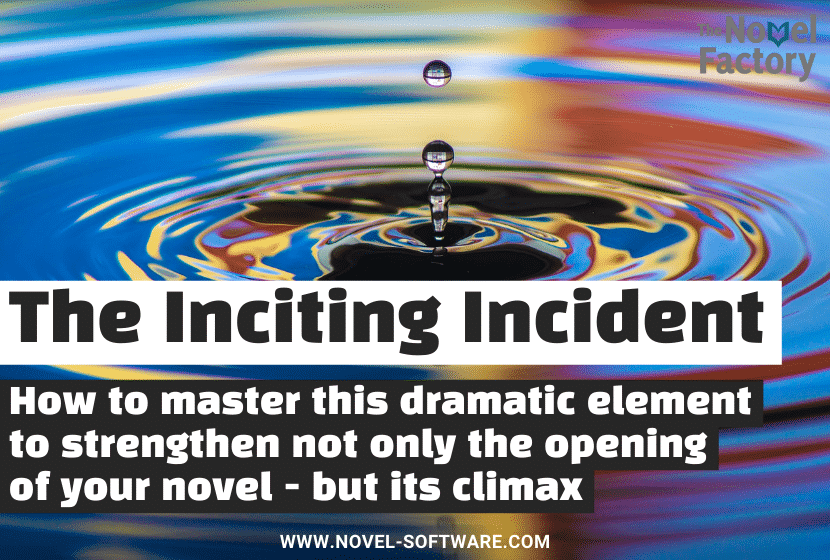
Inciting Incident: How to Grab Your Readers’ Attention
If you’ve been writing for a while it’s likely you’ve heard the term ‘Inciting Incident’.
But do you know exactly what is meant by that term – and more importantly, do you know how to write an effective Inciting Incident?
If you’d like to master this dramatic element and use it to strengthen not just the beginning of your novel, but also the climax – then you’ve come to the right place.
In this article we’re going to look at what an inciting incident is, and how you can use it not only to grab your readers’ attention, but keep them engaged to the very end.
Here are the topics we’ll cover:
- What is an inciting incident?
- What are the common elements of effective Inciting Incidents?
- What are common types of Inciting incidents?
- When does the Inciting Incident happen?
- How is the Inciting Incident reflected in the climax of the story?
- How can you write an effective Inciting Incident?
In this article we’ll answer these questions and more, so let’s begin!
What is an inciting incident?

In essence, an Inciting Incident is something that happens that shakes the protagonist out of their everyday life and sets the story in motion.
This ‘catalyst’ is such an important part of human storytelling that you will find it, or something very similar, in almost all plot structure theories.
In one of the most popular story writing structures, the Hero’s Journey, the Call to Action aligns very closely with the Inciting Incident.
In the popular screenwriting structure Save the Cat it is the ‘Catalyst’ which describes this dramatic element.
Other theories call it The Disturbance, the First Reversal or The Opportunity.
So what do they all have in common? What makes an Inciting Incident an Inciting Incident?
What are the common elements of an Inciting Incident?

Most inciting incidents have the following characteristics.
- They are external
- They are unignorable and potentially life changing
- They are urgent
- They set the main story objective / raise the main story question
- They set the protagonist and the antagonist at odds with each other
Not every inciting incident will include every one of these elements, but you will find that the more of these elements that are present, the more powerful the inciting incident will be.
Let’s look at each of these elements in detail.
As examples to demonstrate each point, we’ll use the inciting incidents from the Hunger Games, Harry Potter and the Girl on the Train.
Warning – there will be multiple spoilers throughout for these three books!
Here are the Inciting Incidents from these three books:
The Hunger Games: When Katniss’s little sister Prim is selected for the Hunger Games.
Harry Potter: When Hagrid breaks into the remote cottage and reads the Hogwarts invitation to Harry..
The Girl on the Train: When Megan Hipwell goes missing.
Inciting Incidents Are External

Effective Inciting Incidents happen to the main character.
Whereas throughout the rest of your novel it’s a good idea to aim for your character to be proactive, directing the action of the story, the Inciting Incident is the one element which is not caused by them.
This feels natural to readers because in real life, we tend to fall into patterns and stick with them, for better or worse.
We rarely wake up one day and simply decide to change our lives.
It takes something that makes us sit up and take notice – whether that’s an opportunity or a threat – in order to jolt us into action.
This externality of the inciting incident can be found in all three of our examples.
In the Hunger Games, Katniss has no control over Prim being selected.
In Harry Potter, Harry has no control over Hagrid turning up or his invitation to the school..
In the Girl on the Train, Rachel has no control of Megan going missing (though in this psychological thriller, at times we’re not sure whether she might).
Inciting Incidents are Unignorable and Potentially Life Changing
As Robert McKee says, “The inciting incident radically upsets the balance of forces in your protagonist’s life.”
Good inciting incidents make it impossible for the protagonist to just shrug and carry on with their day. They should demand attention, and have the potential to turn the hero’s world inside out.
One day you might see an upside down rainbow in the sky. That would be unusual and external – but you could happily go about your day afterward, and your life would be no different. So it wouldn’t work well as an inciting incident, which should be up close and personal.
Note that the tone of the Inciting Incident should match the tone and genre of the novel. So in an epic fantasy, the inciting incident will be dramatic and fantastical. But in an understated period drama, the inciting incident can be understated as well – though no less potentially life changing.
In the Hunger Games, Katniss can hardly go back to her everyday life if the one person she cares about most in the world is in very real danger of a horrible death.
In Harry Potter, a giant breaking down your front door is pretty unignorable and learning that you are a wizard is definitely life changing.
In the Girl on the Train, Rachel could actually technically ignore the Inciting Incident. She didn’t know Megan; it doesn’t directly affect her. However, in the chapters leading up to this incident, we’ve come to understand that Rachel is obsessed with Megan, therefore, her sudden disappearance feels like the disappearance of someone Rachel knows personally, and cares about deeply.
Inciting Incidents are Urgent

For creating drama, inciting incidents should also have a sense of urgency. They should not be something that can be put off dealing with until next week, next month or next year.
Imagine if Katniss’s sister had been chosen for the Hunger Games, but wasn’t going to be taken away for a year. All drama evaporates from the situation. So of course, she’s going to be taken away right now.
When Hagrid arrives and tells Harry he’s a wizard, they leave for Diagon Alley the next day.
In The Girl on the Train the urgency is raised by the fact that Megan may be hurt, and in danger.
They set the main story objective / raise the main story question

Inciting Incidents set the story in motion.
They should raise the goal that the protagonist will be pursuing throughout the story, which can often be expressed as a question.
In the Hunger Games, Katniss’s need to protect her sister causes her to volunteer in her place. This raises the goal and story question: Will Katniss survive the Hunger Games?
In Harry Potter, Hagrid tells Harry he’s a wizard and that he’s to go to the wizarding school of Hogwarts. This raises the main objective and story question: Will Harry survive wizarding school?
In The Girl on the Train the Inciting Incident directly sets the main story objective and question: What has happened to Megan Hipwell?
They set the protagonist and the antagonist at odds with each other

Another common factor of a good Inciting Incident is that it sets the protagonist and the antagonist against each other.
This sets up a satisfying battle between the forces of good and evil, for your readers to be gripped by.
In the Hunger Games it is the Game Makers (and by extension the authority of the Capitol) who are Katniss’s antagonists, and by volunteering in response to the Inciting Incident, she steps directly into their line of fire.
In Harry Potter, Hagrid also tells Harry about what happened to him in the past – how Voldemort killed his parents and then was defeated by Harry, who was merely a helpless baby. So Harry has good reason to hate Voldemort, and Voldemort good reason to hate Harry.
While we don’t know at the beginning what has happened to Megan or who has done it, when Rachel takes it on herself to solve the mystery, she is pitting herself against the hidden antagonist who is responsible for Megan’s disappearance and does not wish to be discovered.
Summary
Remember that not all Inciting Incidents will necessarily contain every single one of these features.
As you can see from the examples, some stories adhere very obviously to the Inciting Incident ‘rules’ whereas others are more subtle.
Every story will interpret these aspects differently, and that is the joy of creativity, imagination and diversity.
The most common inciting incident examples

Inciting Incidents can take all shapes and forms, and creating something unique and compelling is part of the skill of writing.
However, there are some tropes which turn up again and again in stories, so it can be useful to know what they are, and perhaps riff off them or use them as inspiration.
An invitation – often in the form of a letter or phone call – usually an invitation to a new and unknown place.
A mission – in spy novels and thrillers, the hero is often directly handed a mission by their superiors.
A challenge – a proud character may have their honour or integrity challenged, to see if they rise to the bait.
A threat – something happens to put the main character and / or their loved ones in danger.
A request – for example, in detective noir novels, a new client will arrive asking for help
A meetcute – in romance novels it is usually the first meeting between the two potential lovers that sets the story in motion.
In the Hunger Games, the Inciting Incident is clearly a threat.
In Harry Potter, while Hagrid seems threatening to some – the Inciting Incident is actually an invitation – to join wizarding school and start a new life.
In the Girl on the Train, Megan going missing would fall under the category ‘threat’ because as we mentioned above, Rachel has formed an attachment to Megan, despite never having met her.
When does the inciting incident happen?

A very important factor of the Inciting Incident is when it happens.
As we’ve seen, it sets the story in motion, so it can hardly happen towards the end.
Before we can care about the hero’s world being turned upside down, we first need to know what that world looks like right way up.
So before the Inciting Incident, skilled writers will have laid all the foundations for the readers to know what the character wants and needs, what their flaw is, what their world is like, and any exposition which is important to understand what comes next.
However, the Inciting Incident is when the story properly starts, so you should try to get to your inciting incident as soon as possible after doing all the critical setup.
Some editors insist that the inciting incident must come by the end of the first chapter, or the beginning of the second chapter at the latest.
Others stick their pin at the 12% mark or say it happens in the middle of the first act.
These rules of thumb can be very effective and useful tools. However, it’s important not to become too dogmatic about numbers and percentages.
Think about what feels right for your story and your readers. If you’re writing a fast-paced thriller, then you probably need to get to the Inciting Incident pretty fast, to start your reader’s rollercoaster. But if you’re writing a philosophical literary piece, then your readers are probably going to be more patient, and enjoy a slower burn.
Or, you could go the other way, and like MG Leonard in Beetle Boy, put your Inciting Incident in your very first line:
‘Darkus’s Father wasn’t the kind of man to go missing.’
This sentence meets most of the criteria for being an inciting incident. It is external, unignorable, life changing, urgent, raises the main story question (Can Darkus find his missing father?) and sets Darkus against the antagonist (whoever kidnapped Darkus’s father).
Following this opening line Inciting Incident, MG Leonard skillfully fills in the backstory, context and character building we need. However, opening with an Inciting Incident is a tricky thing to pull off, and not for the faint-hearted.
In the Hunger Games Prim is selected for the games at the end of the first chapter. It is page 24 of 454. That is 5% into the book.
In Harry Potter, Hagrid reads out the Hogwarts invitation letter on page 42 of 223 pages. This is 18% into the story. This is chapter four.
In the Girl on the Train, Rachel learns about Megan’s disappearance on page 80 of 409 pages. That is 19% of the way through, in about chapter five.
How is the Inciting Incident reflected in the climax of the story?

The Inciting Incident doesn’t just set up the beginning of the story.
It also sets up the end.
As TV Tropes puts it:
‘[The Inciting Incident] must place in the audience’s mind the notion of what The Climax will be like: if it is the discovery of a shark-bitten corpse on a beach, expect a showdown at the end with said shark; if a farm boy discovers a message of intergalactic espionage, be sure he will follow his journey to the Galactic Overlord.’
In the Hunger Games, when Katniss volunteers for the Hunger Games she shows herself willing to sacrifice herself for what is important to her. Which is how she fights back against the Games Makers at the climax.
In Harry Potter, Harry learns about Voldemort, his nemesis. We instinctively know that Harry and Voldemort will face each other again – which they do at the Climax.
When Rachel learns that Megan is missing, the obvious dramatic conclusion is that she will discover the truth of what’s happened to her, and a confrontation with whoever is responsible.
More tips for writing an effective inciting incident
Consider your inciting incident in relation to the characteristic listed above.
Does it meet some or all of those elements? Is there a way you can add any that are missing – and if so, does that make the Inciting Incident stronger?
When does your inciting incident happen? Is it as early as possible once you’ve laid out important context? Could you move it any earlier by shifting non-critical exposition later?
Think about your ending. Is the Inciting Incident the matching ‘bookend’ for your Climax? Do they link to each other in dramatically satisfying ways? When looked at in hindsight, does the Inciting Incident seem to inevitably lead to the Climax?
Look back over the last few books you read and movies you watched. Can you identify the Inciting Incident? How many of the ‘rules’ above do the writers follow? What effect does this have on how compelling the beginning of the story is and how satisfying the end of the story is?
Summary
Hopefully now you have a firm grasp on what an Inciting Incident is, and how you can write an effective one in your novel.
Don’t forget that everything we offer is ‘tools not rules’ so take what works for you, and leave the rest.
And as a reader and human, you will likely already have internalised many of the aspects that make Inciting Incidents effective, and integrated them into your work, even if you hadn’t read the theory or analysis before.
So keep writing, and enjoy!
And here are some other articles of ours that you might enjoy if you enjoyed this one:
Unlock your writing potential
If you liked this article by the Novel Factory, then why not try the Novel Factory app for writers?
It includes:
- Plot Templates
- Character Questionnaires
- Writing Guides
- Drag & Drop Plotting Tools
- World Building resources
- Much, much more

